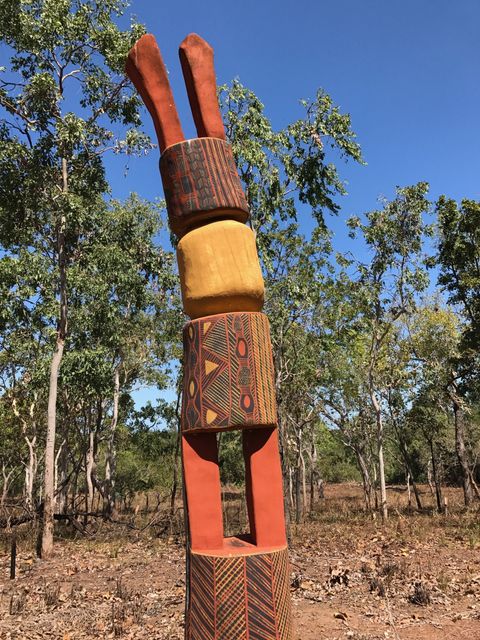History
History
History
The Tiwi Islands have been inhabited for some 20,000 years by indigenous Australians. The creation of the Tiwi Islands is described in the Mudangkala
The Tiwi Islands have been inhabited for some 20,000 years by indigenous Australians. The creation of the Tiwi Islands is described in the Mudangkala
Mudungkala, an old blind woman, rose from the ground at Murupianga in the south east of Melville Island. Clasping her three infants to her breast and crawling on her knees, she travelled slowly north. The fresh water that bubbled up in the track she made became the tideways of the Clarence and Dundas Straits, dividing the two islands from the mainland.
She made her way slowly around the landmass and then, deciding it was too large, created the Aspley Strait, which divides the islands. Mudungkala then decreed that the bare islands be covered with vegetation and inhabited with animals so that her three children left behind would have food. After the Islands were made habitable she vanished. Nobody knows from where she came or, having completed her work, where she disappeared to.
- Tiwi Land Council
The first recorded explorers to the Tiwi Islands were the Dutch in 1636
- navigator Pieter Pieterszoon. In 1644, another Dutch navigator, Abel Tasman passed through the area sailing through the Dundas Strait. Both explorers assumed the Tiwi Islands was one large land mass. In 1705, another Dutch explorer Maarten van Delft made land here, spending several months exploring the Tiwi and Coburg shorelines.
Upon landing, Maarten and his men were attacked by men with spears. From 1650 through to the early 1900’s Macassan traders from Asia would sail down through the Aspley Strait to trade their wares. The Tiwi people were not welcoming to the Macassan traders and therefore no trade was established between them.
The first European settlement in 1824
was at Fort Dundas on Melville Island near where Pirlangimpi now stands. This was the most northern European settlement in Australia. Due to the Tiwi people being hostile to the European, the settlement only lasted until 1829.
In 1911, a Catholic Mission was established -
Francis Xavier Gsell with the Islands being claimed as an Aboriginal reserve in 1912. In 1930, a timber church was built in Wurrumiyanga as a prominent landmark, which continues to have historical significance to the community today and which has featured in a number of Australian feature films - the latest being Top End Wedding. The Catholic mission has had a large impact on the community providing access to education and welfare services.
The mission and government policies helped to establish communities on both Bathurst and Melville Islands - Nguiu, now known as Wurrumiyanga: Snake Bay, now known as Milikapiti and Garden Point, now known as Pirlangimpi.


